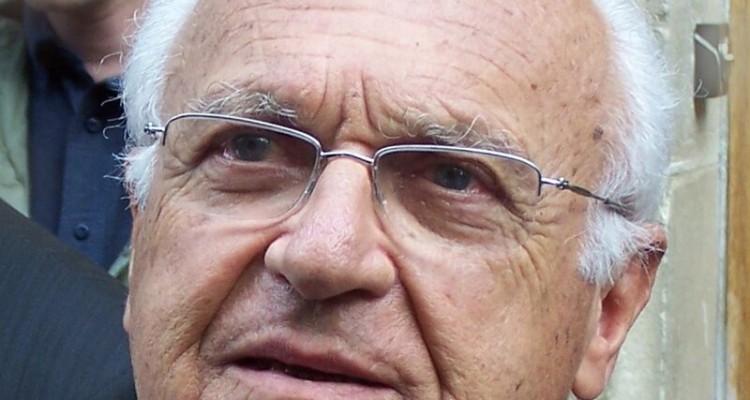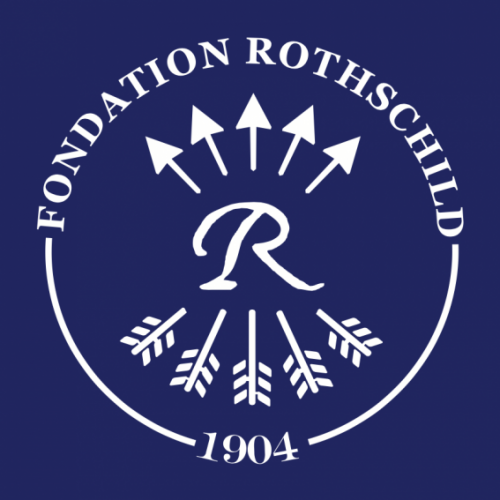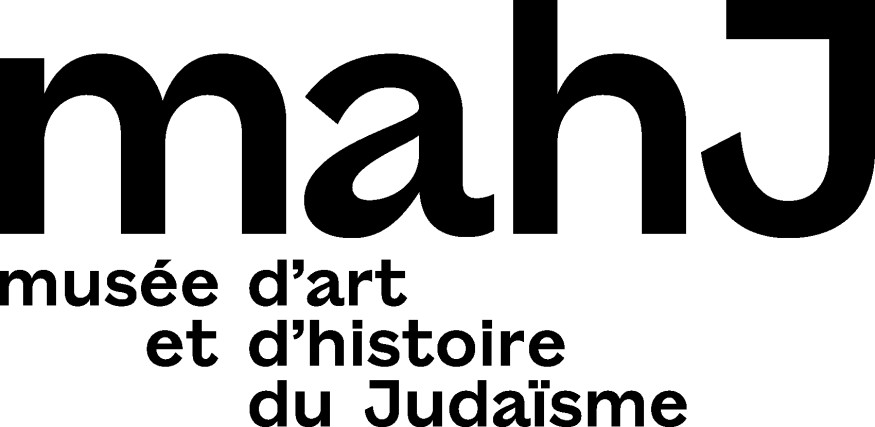On 19 April 1943, the twentieth convoy leaving the Malines transit camp in Belgium for Auschwitz, with 1,631 Jewish deportees on board, was the target of an action led by resistance fighters to free the passengers. In the end, 236 of them jumped from the train that was destined for extermination. Agnès Bensimon looks back at this act of rebellion – the only one of its kind in Western Europe under Nazi rule during the Second World War – to which the Jewish Museum of Belgium has recently devoted an exhibition.
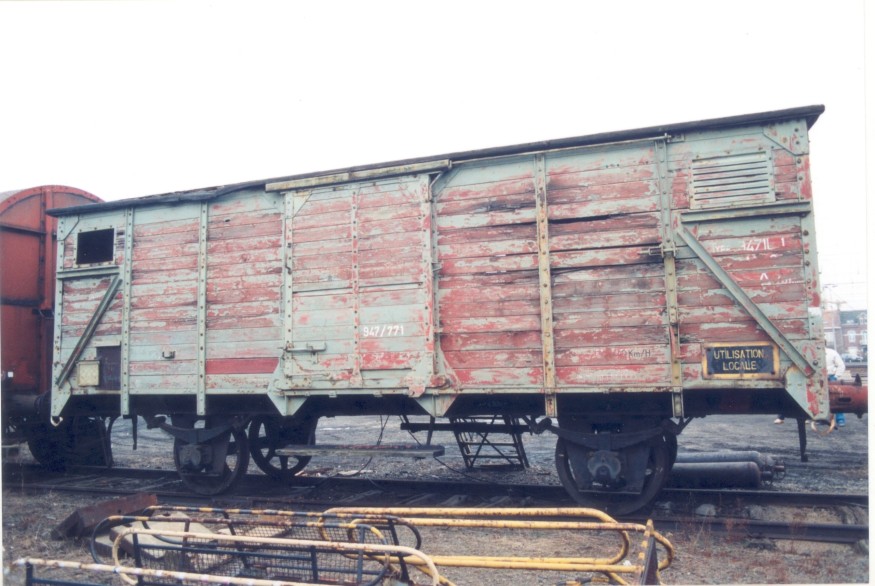
236: the number of escapees from the 20th convoy that left the Dossin barracks in Mechelen, between Brussels and Antwerp, on 19 April 1943, bound for Auschwitz-Birkenau. A heroic act, unique and little-known in the history of deportation: the attack on the train that led to the death of 1,631 Jews by three young men, childhood friends, with no experience and little preparation. Their names were Youra Livchitz, Robert Maistriau and Jean Franklemon. They forced the convoy, which for the first time consisted of cattle cars, to stop ten kilometres after leaving Mechelen. Inside the 40 wagons, groups of resistance fighters had patiently prepared their escape. The uncoordinated convergence of the two actions made this unparalleled feat possible.
The attack on the convoy on 19 April 1943 took place on 14 Nissan 5703, the first evening of the Passover Seder – the festival of freedom for the Jewish people. Coincidentally, the Warsaw ghetto uprising broke out at the same time, more than 1,000 kilometres away. This event, largely unknown outside Belgium, has been documented over the decades by Belgian researchers and historians, in particular Maxime Steinberg (1936-2010), a pioneer of this research and scientific adviser to the Jewish Museum of Deportation and Resistance in Mechelen, and Laurence Schram, a doctor of history, archivist and researcher. Between January and August this year, the Jewish Museum of Belgium revisited this event through an exhibition combining his account, paintings by Luc Tuymans (°Mortsel, 1958) and photographs by Jo Struyven (°Sint-Truiden, 1961).
Dossin barracks, the antechamber of death
Between August 1942 and August 1944, 25,625 Jews and 351 Roma, detained within the walls of the Dossin barracks in Mechelen, were deported mainly to Auschwitz-Birkenau. Of these tens of thousands of deportees, via the 27 transports organised over two years, only 1,395 were still alive when the camps were liberated.
The town of Mechelen was an opportune choice, situated halfway between Antwerp and Brussels, where the majority of Jews in Belgium live. The barracks themselves were close to a service road giving access to the Belgian rail network. The buildings were large, inward-looking and out of sight. In July 1942, the Dossin barracks became the “SS – Sammeläger für Juden – Mechelen”, the Mechelen assembly camp, similar to Drancy in France. The major round-ups in the summer of 1942 marked the beginning of the deportation of so-called “stateless” Jews. From 27 July 1942, prisoners began to arrive at the transit camp, where they were given their registration numbers for future convoys, known as “labour transports”. Belgian Jews were placed on separate lists and were not deported until September 1943.
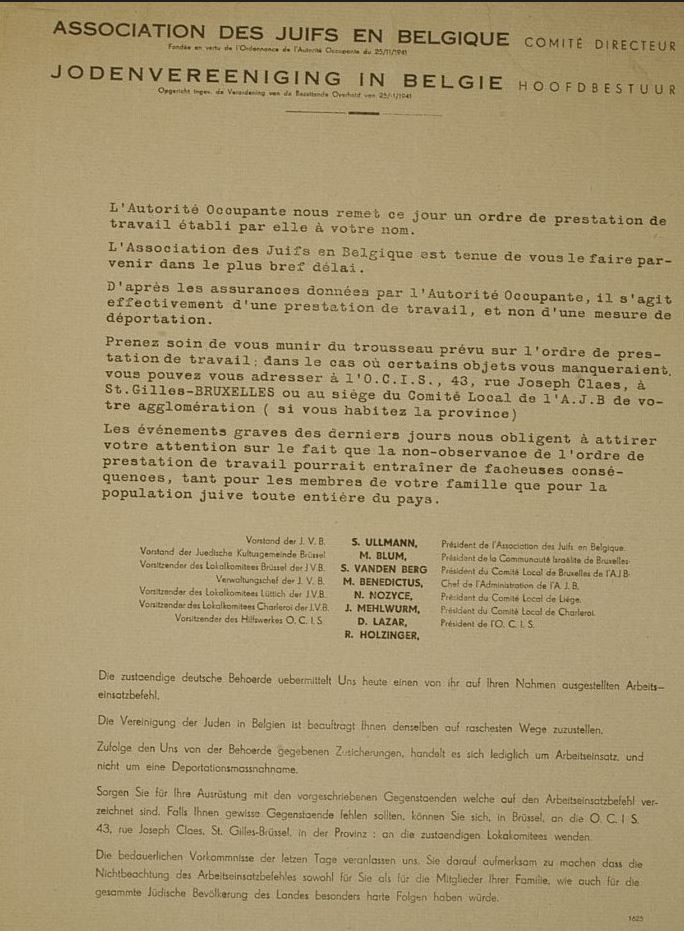
On 29 August 1942, one of the directors of the AJB, Robert Holzinger, nicknamed Gestapo, was shot dead in the street and the AJB office was set on fire by the Jewish resistance. The Red Flag claimed responsibility for the attack in the following terms: “The head of the Jewish Association, who had not hesitated to cooperate with the occupying forces to martyr his fellow Jews, paid for his treason. A vengeful arm shot him down in the street.”</footnote>, an entity equivalent to the Judenrat and made up of community notables, had been created in November 1941. Among other things, the occupier required it to compile registers containing family lists of all Jews residing in the territory. Membership was compulsory and subject to a fee. As a conduit for anti-Jewish measures, the AJB was responsible for sending out (at its own expense) invitations to the “labour transports”. Initially, many Jews answered the call to avoid reprisals. It was their obedience to the measures imposed that ensured the success of the first convoys. There were no more than 20 SS men assigned to “Jewish affairs” in each of Belgium’s four major cities (Antwerp, Brussels, Liège and Charleroi). The first convoy left Malines on 4 August 1942, bound for Auschwitz-Birkenau, with 998 Jews. Gradually, many did not respond and preferred to go into hiding with the help of the resistance or the local population. Under pressure from Kurt Asche[1], the AJB distributed a threatening text (see illustration), which did not make much of an impression. In September 1942, barely 4,000 of the 12,000 Jews summoned turned up voluntarily at the Dossin barracks. Only large-scale roundups were able to fill the convoys, in particular those of August 1942 in Antwerp and the following September in Brussels. From November 1942 onwards, convoy departures became less frequent and the Germans were no longer able to carry out mass arrests, as the Jews had gone underground. The occupying forces never reached their target of 300 arrests a day.
The deportees of the 20th convoy
The 20th convoy was typical of the Final Solution. Its formation began immediately after the departure of the 19th, which left on 15 January 1943. Proof that it was becoming increasingly difficult to achieve the objectives, it took the Nazi authorities 94 days to assemble the convoy. It was made up entirely of Jews arrested at home, betrayed or transferred from various internment centres and prisons.
The Secretary General of the Belgian Ministry of Justice, Gaston Schuind, speaking to the German military command, pointed out that this convoy would include many children “who certainly bear no responsibility for current events and for whom the most elementary humanity prescribes that care be taken”. The 242 children on the list for the 20th transport were not spared, including little Suzanne Kaminski who was barely over a month old. Despite the vain humanitarian efforts of the senior Belgian official, the old people were also sent away, as he noted that they “obviously cannot be used for work. Some were over 80 or even 90 years old”. The oldest, Jacob Blom, was born in 1852. Among the escapees, the youngest was Simon Gronowski, born in 1931, and the oldest, Alex Cleffmann, in 1878.
19 April 1943: the attack on the 20th convoy
By 1943, no one in the various resistance movements or the Jewish Defence Committee (CDJ[2]) had any illusions about these “work transports”. The idea of armed action to free the deportees was formulated by Ghert (Hertz) Jospa, Mauritz Bolle and Roger Van Praag, members of the CDJ, which was set up to provide material aid (money, ration coupons, etc.) and logistical aid (hiding places, shelters, etc.) for the Jews. The Committee did not have the armed experience to envisage such an undertaking. Jospa nevertheless proposed the idea to his instructor from the Communist Party and the Independence Front (IF), but the armed partisans thought it too dangerous. A young Jewish doctor, Youra – Georges – Livchitz, whose older brother Alexandre was a combatant, took it upon himself to carry out the action dreamt up by the CDJ. He approached his friend Robert Leclercq, head of intelligence in a resistance group known as Groupe G, but the members of the network, experts in sabotage, also rejected the plan. Thanks to his friend, like him a former member of the Libre Examen[3] at the University of Brussels, Livchitz obtained a small calibre 6.35 mm revolver. He recruited two former fellow students from the Athénée Royal d’Uccle[4], in Brussels, where they had attended secondary school, Robert Maistriau and Jean (Jan Peter Karel) Franklemon. For Maistriau, it was his first action in the Resistance. Franklemon, an actor, already belonged to a network. On the afternoon of 19 April, a small, inexperienced group was preparing to attack the 20th convoy. Youra, the “leader”, gathered his team-mates at Place Meiser in Brussels and they got on their bikes to reach the Malines-Louvain railway line, at the Haecht road crossing. There, they hid in the thickets of the Boortmeerbeek-Wespelaar section, around ten kilometres from Mechelen, from where, at Muyzen station, a branch line leads via Leuven to the Brussels-Cologne line. All they had was three pliers and a hurricane lamp covered in red paper, which they placed on the track as the train approached. This customary signal warned the driver of the presence of an obstacle that was supposed to force train DA 801 to stop for safety reasons. In his testimony, Albert Simon, the engine driver, stated that he had observed the signal, recognised it as unusual and not in order, but had deliberately stopped the locomotive, as he had already slowed the convoy on several occasions since leaving Malines, as a sign of resistance to the deportation plan. The young men’s plan was very simple: Livchitz would point his pistol at the driver to immobilise him, while Maistriau and Franklemon would open as many carriages as possible by distributing the fifty-franc notes that the CDJ had given them to help the escapees.

Two unforeseen factors were to derail the initial plan: for the first time in the history of deportation, the Jews were locked in cattle cars, which were more difficult to open; and for the first time, the escort had been split: part of it had taken its place at the front of the train, in addition to the usual caboose. Livchitz was unaware of these changes. A few minutes after the attack began, the Schupo reacted. The attackers and the escapees were caught in the crossfire. Armed with his 6.35mm, the wounded Youra Livchitz had to retreat, firing at the soldiers in pursuit. Jean Franklemon, threatened by a soldier near the locomotive, did not have time to open a single carriage. Somehow, amid the fury of the gunfire, Robert Maistriau managed to open the 17th of the 40 wagons in the convoy. Fifteen to seventeen deportees jumped to freedom.
The rebels of the 20th convoy
Following the attack on the XXth convoy, which stopped the train and created the confusion needed for action, the organised Resistance carried out its escape plans. In the mass of rumours, that of an action by an armed group had spread, without convincing. In fact, the members of the Resistance did not expect to be saved by outside intervention and had planned to escape by their own means. In fact, some of the prisoners waiting for the 20th convoy belonged to the Resistance, unbeknownst to the camp’s SS, for whom they were deportees for the evacuation of Jews. Although they did not belong to the same structures, they knew each other personally and were together when they arrived in Malines. As the convoy had taken more than three months to form, they had had time to organise their escape.
They even formed a “resistance wagon”, so called because it included members of the armed partisans. The numbers on the transport lists had been altered to enable them to be reunited for their escape. One of the first inmates of the Dossin barracks, Eva Fartag, who was in charge of registering deportees on the Transportlist, played a key role in the formation of this wagon, at her own risk.
Among the escaped Resistance fighters was Jacques Cyngiser, a shoemaker and veteran of the Spanish Civil War, who had joined the Jewish company of the Mobile Partisan Corps, part of the MOI, the Immigrant Labour Force, like the Hungarian Jew Sandor Weiss, who was interned with him in Mechelen. Cyngiser was put in charge of the wagon. As the architect of the escape, he collected as many tools as possible, found either in the workshops or in the parcels. On the day of departure, one had a small saw, another had a corkscrew hidden in a parcel. As soon as the train started moving, they set about attacking the carriage door.

Another special feature of this 20th convoy was the “special list”, which included 19 deportees who had already escaped from a previous transport but had been apprehended again. In the Mechelen camp, they were nicknamed “flitsers” (runaways, in Yiddish). Alerted to the guards’ vigilance by paint marks on their clothes, they had been placed in a separate wagon at the back of the transport, where the Schupos could keep an eye on them more easily. Despite these measures, six of them escaped.
In a moving memoir published in 1979, “Conte à rebours, une résistante juive sous l’occupation”, Claire Prowizur-Szyper, who died last year (she was 101 years old) and living in Israel since 1969, recounts how resistance fighters from the Trotskyist PSR movement, including her husband, had also ensured that tools were smuggled into the carriages. Despite the pain of abandoning her ailing father, Claire jumped off the stationary train with the help of her husband. In the end, they reached the crossing point for a local tram to Liège without being stopped. They continued their resistance activities to the end.
The youngest escapee, Simon Gronowski, aged 11, jumped off the train with other deportees at the behest of his mother Hana, who was unable to follow him. Fearing for his life, he walked alone, in the dead of night, to the hamlet of Berlingen, near Borgloon, where a woman opened her door and took him to the village warden, who in turn entrusted him to gendarme Jean Aerts, who was ready to hide the child. Simon was determined to find his father in Brussels, and the gendarme accompanied him to the station. He later recounted his childhood under the occupation in “L’enfant du XXe convoi”, published in 2002, and in an illustrated children’s book, “Simon, le petit évadé”. Since then, he has never ceased to bear witness for younger generations. On 27 January this year, aged 91, he accompanied a group of schoolchildren on a visit to Auschwitz-Birkenau.
Not all of the 236 “jumpers” were so lucky. 26 of them were shot and 92 immediately recaptured. But the 118 successful escapes were a record.
What happened to the three daring young boys after their action? Youra Livchitz, who was the first to believe that an attack on a deportation convoy was possible, was wounded by a shot. Taking refuge with the parents of a friend, who looked after him as best they could, he wanted to warn his team-mates, but the man who received the information to pass on was an informer working for the Gestapo. Denounced, he was arrested a month after the event, as were his hosts, who were also Resistance fighters. Youra Livchitz nevertheless made a spectacular escape from Gestapo headquarters by overpowering his guard and then putting on his uniform. His new-found freedom was short-lived: on 26 June 1943, he and his brother Alexandre were arrested by the Feldgendarmerie as they were planning to cross to England. Youra Livchitz was executed on 17 February 1944 at the Schaerbeek shooting range for his part in the armed liberation action of the XXth convoy. He was 26 years old. A few hours before his execution, he wrote a magnificent farewell letter to his mother. Heroic to the end, he refused to be blindfolded in front of the firing squad.

Robert Maistriau hid in the Ardennes after the attack and joined the Groupe G headquarters, where he was responsible for training new Resistance fighters. He took part in sabotage operations, before being arrested in March 1944 by the Sipo and imprisoned at Breendonk Fort[5] then deported in May to Buchenwald. After a five-day death march, he arrived at Bergen-Belsen, where he remained until the camp’s liberation on 15 April 1945, before being repatriated to Belgium at the end of the month. In 1994, he was recognised as “Righteous Among the Nations” by the Yad Vashem Memorial. He died in Brussels in 2008.
Jean Franklemon was arrested on 4 August 1943 and also transferred to Breendonk fort. Sentenced by the German military court to six years’ imprisonment “for actions that harmed members of the Wehrmacht and for unjustly releasing prisoners during transport”, he was transferred to Germany and imprisoned in the Sonnenburg concentration camp, then in Sachsenhausen. He was held there from 15 November 1944 to 4 May 1945 and survived the death marches. After the war, Jean Franklemon became a musician in East Germany, where he remained faithful to his communist ideals until his death in 1977.
The fate of the deportees of the 20th convoy
What do we know about the fate of the deportees from the 20th convoy on their arrival at Auschwitz? Laurence Schram, a doctorate in history and researcher at the Jewish Museum of the Deportation and the Resistance, has patiently pieced together the facts to answer this question: “It’s not just the attack and the mass escapes that distinguish the 20th transport from the other deportation trains from Mechelen to Auschwitz. The part of its history in Auschwitz-Birkenau also has some special and, all in all, unexpected aspects. A historical publication on this convoy should also attempt to retrace the itinerary of the 1,404 deportees who got off the train in Auschwitz, to situate the killing of most of them in Birkenau and to identify the traces of the others in the world of the camps”.
The train arrived at its destination a day late, on 22 April 1943, without stopping at Auschwitz station. The deportees were unloaded directly onto the Judenrampe. As soon as they got off the train, 883 people were taken to the gas chamber, the vast majority of them women (80%) and most of them children. “But getting off the train and the selection that followed did not go smoothly. The selection and transport to the gas-cremation chambers of the deportees doomed to immediate death probably took place in a climate of agitation, rebellion and even violence, leading the SS at Auschwitz to protest to Berlin, where Eichmann’s department passed on the reprimand to those responsible for the deportation of Jews from Belgium, France and the Netherlands”, Laurence Schram tells us. To prevent the spread of alarming rumours, the SS at Auschwitz launched “Mail Actions”. New internees had to write reassuring postcards to the AJB or to their relatives in Belgium. These cards were forwarded to the Sipo-SD, which gave them to the AJB to send to their addressees.

In fact, 276 men were subjected to forced labour. Of the 245 women who arrived from Malines, 112 were assigned to Blok 10 in Birkenau, the “medical experiments” block. SS doctor August Hirt at the Struthof-Natzweiler camp in Alsace also took an interest in the Auschwitz guinea pigs to develop his collection of Jewish skulls and skeletons, with the aim of proving the superiority of the Aryan race. Himmler, who supported the project, arranged for him to deliver around a hundred corpses from Birkenau. 86 of these bodies were found very recently, preserved in formaldehyde, hidden in the cellars of the Strasbourg Institute of Anatomy (link to Maelle article). All were tattooed, and it is thanks to this indelible mark that, fifty years later, Hans-Joachim Lang, journalist and historian, was able to identify them. Among the corpses were six women deported from Mechelen on 19 April 1943.
When the camps were liberated, the return of 88 men, 65 women and 3 children from the 20th convoy was organised.
80 years later
The attack on the 20th convoy was a unique event in the history of the deportation of European Jews. In Belgium, 80 years on, various initiatives have been taken to commemorate the exploits of the three young resistance fighters and the courage of the escapees.
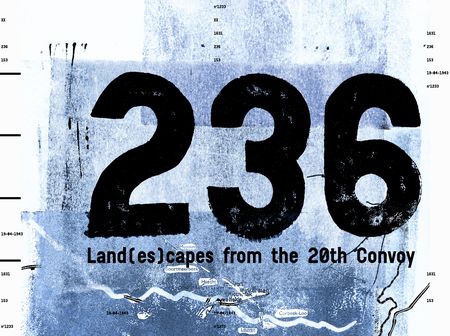
The Jewish Museum of Belgium recently paid tribute to them by exhibiting the faces and names of the 236 escapees from the 20th convoy, identified thanks to the immense work of the archivists at the Documentation Centre on the Holocaust and Human Rights in Mechelen. The exhibition “236- Land (es)capes from the 20th Convoy” opened on 20 January 2023, and the Auschwitz Foundation has published a remarkable catalogue on the 20th Convoy to mark the 80th anniversary of the attack on 19 April 1943.
Two contemporary artists, the painter Luc Thuymans (whose grandparents were Flemish Nazis) and the photographer Jo Struyven, accompanied the exhibition with their work. Looking back on this act of resistance, the photographer showed the landscapes in which this unique event took place. With 19 large-format black-and-white night photographs, the artist created a contemporary ‘memorial’. A single colour print showed the house where little Simon had sought help. The 20th convoy passed through a large part of the region where I grew up, just 50 metres from my childhood home,” explained Jo Struyven. I found out about it when I met Simon Gronowski. Since then, I’ve never stopped imagining the distress of the deportees.”
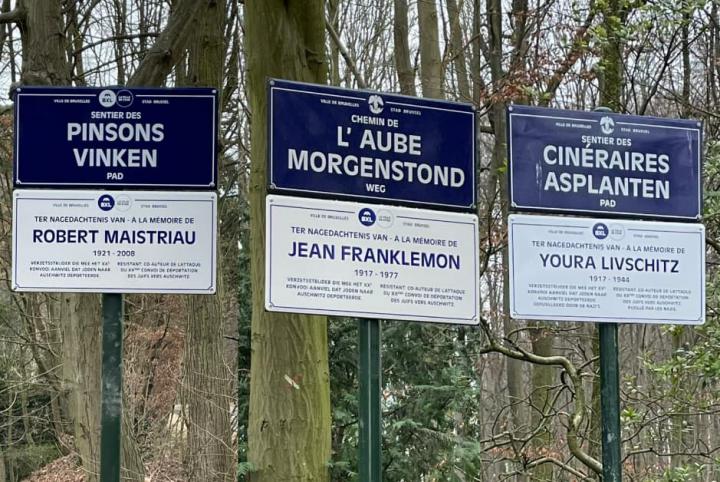
The City of Brussels has honoured the heroes of the attack on the 20th convoy by unveiling three commemorative plaques in their names in the alleys of the Bois de la Cambre, in the heart of the capital.
Agnès Bensimon
Notes
| 1 | Kurt Asche held the rank of Obersturmfürer in the SS. He was the Jewish affairs adviser responsible for supervising the application of anti-Jewish measures and deportation in Belgium, from August 1942 to October 1943. |
| 2 | The CDJ was a Belgian resistance organisation, affiliated to the Independence Front, founded by the Jewish communist Hertz Jospa and his wife Have Groisman – Yvonne Jospa, in September 1942. |
| 3 | The Libre Examen is the founding principle of the Université Libre de Bruxelles. The first article of the organic statutes, in 1894 stipulated that “Teaching at the University requires free examination”. |
| 4 | Three teachers and 14 students from the Athénée Royal d’Uccle died in the Resistance, 8 of them were shot by the Germans. |
| 5 | Breendonk Fort, 20 km south of Antwerp, was used as a concentration camp and then as a transit camp during the Second World War. Resistance fighters and hostages were tortured and abused there. It was run with an iron fist under the command of Sturmbannfürer Philipp Schmitt. He was the only war criminal to be executed in Belgium. Read “Breendonk 1940-1945”, Patrick Nefors. Ed. Racine. 2005. 356 p. |


